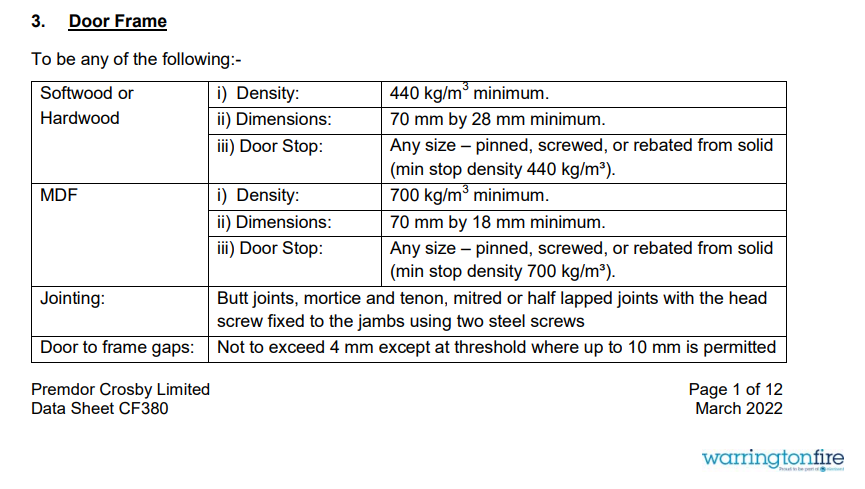-
Posts
505 -
Joined
-
Last visited
Everything posted by Neil Ashdown MAFDI
-
The double leaf doors, if fire doors, should have intumescent seals and smoke seals at the meeting edges too. Loss of Certifire labels is a common issue but a competent fire door inspector would usually be able to identify the doors using residual pieces of label and manufacturer marks on the doors. There are 45 doors so there's a reasonable chance that enough information is still present, assuming all doors are the same. More of an issue, usually is where the door has been incorrectly installed thus invalidating the product certification.
-

Fire door sets never fit openings
Neil Ashdown MAFDI replied to Chris562's topic in Fire Doors and Accessories
If you go for an 'off the shelf' fire door leaf, be aware that trim allowances are often very tight. It may be necessary to use thicker door frames to comply with fire door leaf installation instructions, where the surrounding wall to door frame gap would otherwise be too large. So my guess would be no better than 50 / 50, depending on the type of property, and I would be ready to expect to have to order custom made doors or fabricate them from door blanks. However, there are some 'off the shelf' fire doors (Premdor CF625 solid GDC chipboard for example) that permit significant trimming off the bottom edge. -

Fire door sets never fit openings
Neil Ashdown MAFDI replied to Chris562's topic in Fire Doors and Accessories
As Mike says, that's the whole point of the survey. So that you can order the correct sized door and if you can't get what you need 'off the shelf' you can get them custom made. Clearly, if you did have a workshop you could fabricate the doors using certificated fire door blanks. But you need will also need the knowledge to do it correctly to retain that certification. -

Fire door sets never fit openings
Neil Ashdown MAFDI replied to Chris562's topic in Fire Doors and Accessories
If you carry out a full on-site survey for each door before you purchase the door-sets and order them accordingly, you should be OK. -
So clearly you have identified risks that the doors may not be adequate in resisting fire and smoke spread. Therefore these need to be considered carefully and addressed appropriately. The performance required from those doors may very well depend on how the building is used. For example if there's sleeping accommodation then the risk could be high but if its an office the risk could be low. For best effect prioritise your remedial works according to the risk to people at the building. All of the defects you describe can be resolved but some may be challenging.
-

Are specific fire door gaps a legal requirement?
Neil Ashdown MAFDI replied to a topic in Fire Doors and Accessories
The 4mm max gap is specified by the fire door manufacturer based on their evidence of performance from fire resistance tests to BS 476-22 and/or EN 1634-1. So its a requirement otherwise the fire performance certification becomes void. Obviously, once the door is installed at the building those gaps might change when the door is subject to high humidity or excessive temperatures. Then it becomes a maintenance issue and the Fire Risk Assessor/Fire Safety Officer for the building should be consulted where there are issues around maintaining the 2mm to 4mm gap. Prioritising the cold smoke spread issue might well be a suitable strategy but its a decision for the FRA/FSO rather than the maintenance team. There is also guidance at BS 8214: 2016 stating gaps should be 2mm to 4mm for optimum fire resistance performance. -
In terms of how you use the door's Certifire certificate of approval for it's fire rating, the certificate should be relevant to the date when the door was installed.
-

Are specific fire door gaps a legal requirement?
Neil Ashdown MAFDI replied to a topic in Fire Doors and Accessories
As far as fire door specific standards are concerned its non-compliant and the smoke seals are ineffective due to the 2mm gap. Refer to BS 8214: 2016. So in terms of fire safety, this would be the subject of an assessment by a Fire Risk Assessor and depend largely the door function, location and the use of the building. -
Furthermore, to sustain a live fire oxygen is a necessary element. Therefore, the larger the threshold gap then the more oxygen can pass under the door to help sustain the fire.
-
Where a threshold gap is more than 10mm this could cause the door to fail to provide its 'ultimate' fire resistance as tested to BS 476 part 22 or EN 1634-1. You say that smoke is not the issue in your case so we will not address that separate issue here. The larger the threshold gap then the farther the door leaf can drop to the floor when the hinges fail to hold the door in position due to fire attack at those hinge positions. Therefore, a gap would open-up at the top edge of the door and the larger the gap, then the higher the risk of failure. So we are talking here about 'ultimate fire resistance performance' and this is the type of consideration that must be made by the fire risk assessor when deciding whether or not an existing fire door would provide adequate protection in a fire.
-

Types of locks on flat entrance doors
Neil Ashdown MAFDI replied to a topic in Fire Doors and Accessories
Guidance available here: https://assets.publishing.service.gov.uk/government/uploads/system/uploads/attachment_data/file/1124733/Approved_Document_B__fire_safety__volume_1_-_Dwellings__2019_edition_incorporating_2020_and_2022_amendments.pdf Building Regs Approved Document B appendix C section C15. Also 'Hardware for Fire & Escape Doors: Code of Practice' http://firecode.org.uk/Code_of_Practice_hardware_for_fire_and_escape_doors.pdf Clearly, this door is damaged beyond repair at the closing stile and the markings on the lock faceplate cannot be read from the photo so unsure if the lock pre-dates Construction Products Regulations. All parts of the lock should be fitted tightly to the door leaf and door frame with no unnecessary gaps or voids from 'over-morticing' and at the correct position (usually between 800mm and 1200mm from the bottom edge of the door depending on the door manufacturers installation requirements). -
Could the conservatory be part of the house? That would be the criteria for Building Regulations, I think. Local Building Control might be able to answer your question.
-

Do door stops have to be of particular thickness?
Neil Ashdown MAFDI replied to a topic in Fire Doors and Accessories
At a hotel- 11 replies
-
- door stops
- fire door
-
(and 1 more)
Tagged with:
-

Do door stops have to be of particular thickness?
Neil Ashdown MAFDI replied to a topic in Fire Doors and Accessories
It is understood that fire doors offer improved performance when fitted with intumescent edges seals and obviously smoke seals, so this would be a matter for your fire risk assessment.- 11 replies
-
- door stops
- fire door
-
(and 1 more)
Tagged with:
-

Double door with gap in the middle
Neil Ashdown MAFDI replied to a topic in Fire Doors and Accessories
Here is an example of 10mm intumescent seals fitted to rebated meeting edges. But the installer should check the specific requirements with the particular fire door manufacturer. -

Fire door inspection
Neil Ashdown MAFDI replied to Chris sutherland's topic in Fire Doors and Accessories
https://www.firedoorscomplete.com/training-qualification -

Front Entrance Doors - Fan Light Issue
Neil Ashdown MAFDI replied to 54321M's topic in Fire Doors and Accessories
The door supplier is correct that its very unlikely that any fire door set will have evidence of fire resistance performance with fire-stopped services passing through any part of it. On the flip side there are many fire-stopping products with certification for fire resistance performance when used with cables and pipes passing through walls. Consult a fire-stopping specialist for advice. -
Refer to the specific fire door leaf manufacturer's installation instructions or product data sheet for information about door rebate stop requirements. For example only:
-
When inspecting fire doors, two of the key requirements are that products used for repairs and upgrades have suitable evidence of performance and that they are fitted correctly. These products have evidence of performance and need to be fitted in accordance with the manufacturer's requirements.
-
You can download product data including the DoP and evidence of performance here https://framefit.co.uk/
-
Some fire doors can have apertures for fire resistant and smoke restricting letter plates. My advice would be to engage a competent & experienced fire door inspector to verify whether or not the doors are suitable in terms of their fire and smoke performance, as flat entrance doors.
-
This might help? Lots of technical data on fire door blanks and you can contact their Technical Dept to discuss your plans: https://falcon-timber.com/downloads/
-
https://www.firedoorscomplete.com/news/can-i-certify-a-fire-door The same goes for maintenance and repairs.
-

Reducing gaps between door and frame
Neil Ashdown MAFDI replied to a topic in Fire Doors and Accessories
For a certificated fire door made in say 2007, the only certification you can reliably use would be the certification issued at that time. This is because of the possibility that that certification published later may refer to a door design that has been revised in some way and therefore different to the original door. Obviously, the certification refers to a particular design of door and can only be applied as such. The same manufacturer may have many different door designs. -

Fire doors in a domestic 3 storey house
Neil Ashdown MAFDI replied to a topic in Fire Doors and Accessories
https://www.gov.uk/government/publications/fire-safety-in-purpose-built-blocks-of-flats



